長野電鉄線

2019年2月、雪舞い散るある日、僕は長野駅に降り立った。
冬の雪深い風景を前に、シティボーイの僕の心は、わくわくと高鳴っている。
目的地は、ずばり長野電鉄。

まるで都会の洞窟のような長野駅から、旅は始まった。
オシャレな入口を抜けて、僕は期待に胸を膨らませて地下に降りていく。

さっきまでの洗練された入り口とは打って変わって、目の前にはまるで昭和にタイムスリップしたみたいな地下鉄が広がっていた。
長野電鉄は、長野から湯田中の33.2kmを結ぶ路線である。
昔は須坂から屋代までを結ぶ屋代(やしろ)線、信州中野から木島までを結ぶ河東(かとう)線もあったわけだが、2000年代になると、そのいずれも姿を消してしまった。

さて、この惻惻とした侘しさのあるホームは地鉄ファンにはたまらない。
「寂寥のホーム御開帳、たまらぬ会長タマランチ」などという意味不明な狂歌を心の中で呟きながら、昔ながらの地下鉄の光景に目を奪われてしまった。
地下のプラットフォームは確かに古くさくて、なんか昔の神戸電鉄の新開地駅みたいな雰囲気でいい感じだ。

東急から来た8500系T6編成がいたのだが、これがまたちょっと変わった顔をしてるのだ。中間車を改造したからだろうか。
貫通扉っぽく見える中央の窓に銀色の縁取りがしてあり、それがまたよく見るとイミテーションなのである。
どこぞの新京成800形もそうだけど、これをすることで小顔効果的ものでもあるのだろうか?
不思議なのは、この車両だけなぜか種別表示器の内側に、通過標識灯がついている。この写真だと灯がついていないのでわかり難い。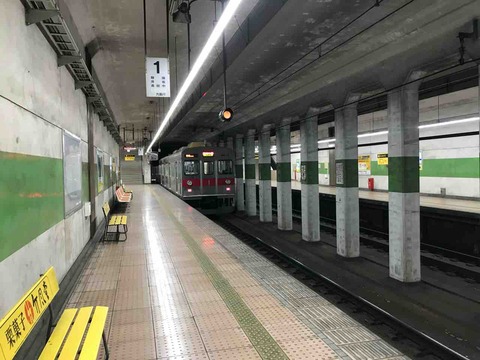
長野駅の隣にある市役所前駅に行くと、その隣の権堂駅、さらにその隣の善光寺下駅と、地下区間はどこも昭和の東京の地下鉄みたいな雰囲気がある。
壁の煤け具合など、廃墟のそれである。

相対式ホーム間の柱には、縦型の駅名標が設置されている。

駅名標。駅ナンバリングシステムにもちゃんと対応している。昔の営団地下鉄のようなデザインだけど、こういうところは近代の鉄道ってわけである。

赤い消火栓もあって、その煤けた感じが、昭和の匂いをぷんぷんと放っている。なんとなく、廃病院の片隅みたいだ。
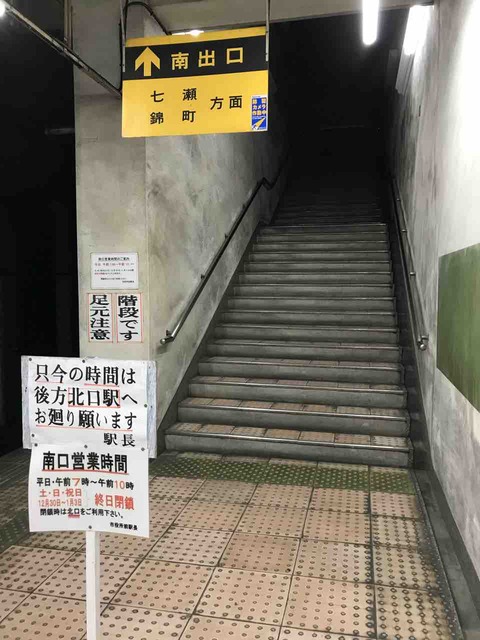
そして、この階段。平日の朝だけ、南口へと続くこの階段が人々を運ぶ。

鏡広告を見ると、文字のフォントが、まるでタイムスリップしたかのよう。道ゆく人に、すいません今昭和何年ですか?って聞きたくなるくらいである。

使われなくなった発光式の広告もある。かつての輝きを背に、今はただ裏返しにされた板がそこに在る。

黄色や青のベンチ。統一感はないが、そこにまた地方私鉄らしさを感じる。

禁煙の表示は手書き。妙に達筆なのもまた昭和くさい。

何度も言うけれど、

ここは昭和の東京ではない。平成31年の長野なのである。

昔ながらの水道。右側の蛇口は清掃用だと思う。

近年設置されたらしい電光掲示板。

市役所前駅を降りて、沿線を散策することにした。古くさい駅構内を抜けて、出口を目指す。
床タイルも壁も時の流れによる老朽化が際立っている。

案内板。
この色使いは完全に昭和のセンスってやつだ。

簡易的すぎるほど簡易的な駅構内図と時刻表。
ちなみに、ここ市役所前駅は、B特急の停車となっている。

で、市役所前を出て、権堂方面に向かって、雪の中を歩いてみたんだ。人っ子一人いない静寂。
権堂周辺は、長野屈指の歓楽街。路地を一本入ればキャバクラやスナック、小さな飲み屋がいくつも入居するビルが軒を連ねる。

台湾や中国系のスナックもある。どの店がいいかな?
僕なら李(リー)で決まり。

昼間だからだれもいない。雪だけがしんしんと降っている。
世界に一人だけ残されたような。

休憩所も閉まっている。平日のせいか。
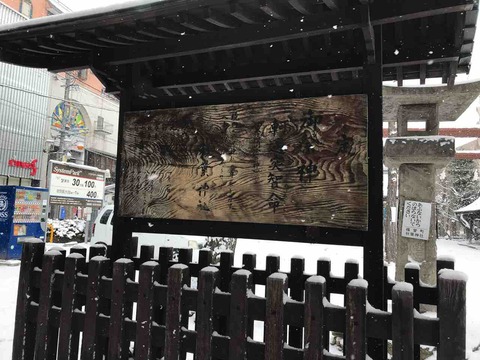
秋葉神社にたどり着く。
由緒書きを読んでみると、御祭神は軻遇突智命(かぐづちのみこと)で、火盗消除の神様だという。

立派な鳥居がシンボル。商店街の中心にあり地元民に親しまれているんだろう。

権堂駅に到着して、また電車に乗って、今度は須坂方面に向かう。

駅名標は市役所前と同じで、営団地下鉄みたいなデザイン。地下区間は駅名標が統一されている。

この駅は、市役所駅と雰囲気が似てるのだが色が違っている。オレンジ、緑、青って、各駅ごとに色が決まっているわけだ。
これがあると、ふとした瞬間に「あ、ここどこだっけ?」みたいにならないというわけだ。

ホームの端にある謎の階段。非常用なのだろうか?真っ暗で、その先に何があるのかさっぱりだった。

権堂駅を出て、3600系に乗って、さて、どこへ行くか考えながら揺られている。さっきまで地下をブラブラしていたら、時間があんまりなくなってしまった。
でも、ちょっとネットで調べたら、村山橋近くにいい撮影スポットがあるらしい。そこに行ってしまおう。

村山駅に着いて、ちょっと長野方面に戻ると、その撮影スポットがあるらしい。
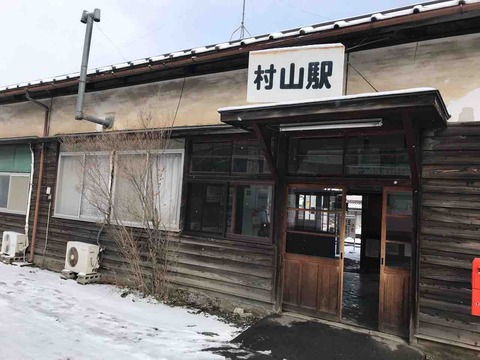
村山駅自体は大正15年から存在していて、今の駅舎は昭和28年から在る説が有力らしいが、よくわからない。とにかく古いというわけだ。
2009年に無人駅になってしまっているが、歴史を感じさせる。

その2009年に架け替えられた村山橋。その近くの小さな公園には、昔の村山橋を記念して、旧橋の一部が展示されている。


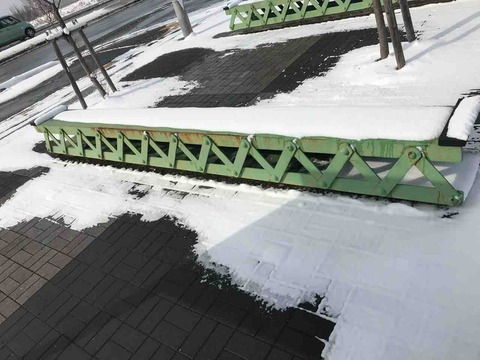
旧村山橋の展示たち。

そこへ元東急の8500系がやってきたり、、、

反対方向からは元成田エクスプレスの2100系が雪を巻き上げながら現れたりする。2100系は「スノーモンキー」って呼ばれていて、長野電鉄に来てからも、まだまだ現役バリバリである。
JR時代のグリーン個室も残されていて、なんと1000円で利用することができる。長野電鉄の特急料金は100円なので、1100円払えば一人で乗ることもできちゃうわけだからお得としか言いようがない。

続いて元営団地下鉄3000系、2両編成の長野電鉄3500系がやってきた。

最後は須坂駅にたどり着いた。ここにはN3編成が停車中。

雪と8500系のコントラストが、なんとも言えない雰囲気を醸し出している。
でも、駅前には何もなかったなぁ・・・。

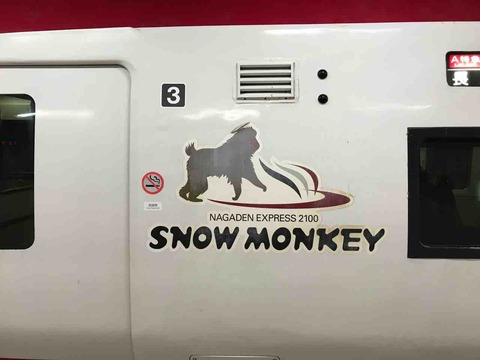
結局、須坂からスノーモンキーに乗り込み、長野に戻った。
長野電鉄沿線は過去にはスキーブームで栄華を誇ったが、今では夕日が差しかかっている。
ただ、僕は東京のギラギラとした街よりも、黄昏ゆくこの長野電鉄沿線の街がすきだ。
駅前の酒場で、通りすがりの僕は身勝手な感傷にひたりつつ、この日の終わりを迎えた。